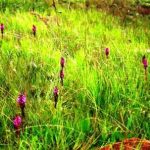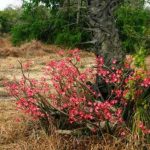TREE LIFE
August 2005
MASHONALAND CALENDAR
Saturday 6th August: Botanic Garden Walk. Subject ‘This and That’. Mark is standing in for Tom who is on leave. Meet in the car park at 10.45 for 11 am.
Sunday 21st August: Because of the fuel crisis, please phone Mark or Maureen to confirm that this trip is still on. Eleanor and Norman Dickens have a property on the Umwindsi River and have kindly invited us to spend the day with them. We have enjoyed this property on a previous outing but at a different time of year.
Bring your chair and lunch, and we will meet at 9.30 am.
Saturday 27th August: For Mark’s walk this month we visit the home of Mrs. Black at Mandara.
We will meet Mrs. Black at 2.30pm at the homestead.
Saturday 3rd September: Botanic Garden Walk.
MATABELELAND CALENDAR.
Please contact Jean Wiley or Gill Short for details of the next Matabeleland function.
A TREELESS OUTING. February 2005 Part 11
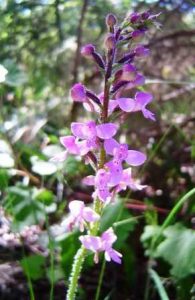
Cynorkis kassneriana. Photo: Bart Wursten. Source: Flora of Zimbabwe
We decided to drive to World’s View on the second day. Similar in habitat and altitude to Mt Rukotso, it would probably yield another good harvest of orchids, while Mark and Werner promised to show us some more species they had seen on their trip to Ezulwini. We hadn’t even left the estate before we found the first species, and in unlikely habitat as well. In the shade of a well established pine plantation we found three species, obviously not so peculiar in their habitat preferences. Cynorkis kassneriana is another orchid with glandular hairs on most of its parts, including the flower itself. The stem of lovely pink, spotted flowers has a single leaf at the base. It is a common species, found on forest edges, shady road banks and in high altitude Miombo woodland. Its preference for acidic soils not only enables it to grow under pines but even makes it keen to do so.
The other two were species of Disperis, each forming extensive but distinctly different pink or white patches on the pine forest floor. Disperis is a genus of small terrestrial orchids found mainly in Africa, Madagascar and other Indian Ocean Islands. A few species are known from Asia. In Zimbabwe 10 species have been recorded. Most favour shady locations in leaf litter on the forest floor. They are easily distinguished by the sac-like spurs, which are not borne on the lip or the hood but on the spreading lateral sepals. The lip is usually not clearly visible but, when extracted from the flowers, shows to have peculiar appendages.
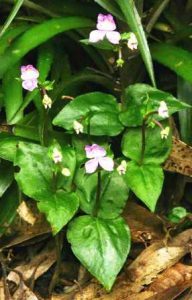
Disperis dicerochila. Photo: Bart Wursten. Source: Flora of Zimbabwe
The pink-flowered species was D. dicerochila. The white species proved to be a bit of a puzzle. It is a species commonly found in places like Nyanga and I know it well from the forests in the Vumba. It is always pure white and has small, horn-like folds at the top of the hood. It looks clearly and consistently different from D. dicerochila but it does not seem to be distinguished by the relevant authorities. Werner thinks it might be more closely related to D. thomensis, which is believed to occur only in Malawi and Zambia.
Our progress towards the day’s goal was made in good Tree Society fashion. That is to say, we still had not reached World’s View by lunch time, because there was so much to look at on the way. Along the main road to Troutbeck, Werner stopped at various places to show that orchids do not always grow in far-away, exotic places. Like pine plantations, roadsides are not where you’d expect to find orchids. Once they are well enough established however, roadside ditches may form ideal artificial vleis and seepage zones.
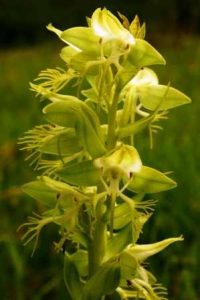
Habenaria praestans. Photo: Bart Wursten. Source: Flora of Zimbabwe
One such place gave us Habenaria praestans. This species represents in Habenaria what Star Wars is in cinematic special effects. The lip is not just 3-lobed but has a comb of tentacles on each lobe; the hooded flowers are at least twice the size of most other Habenaria species; and parts of the column look like the eyes and jaws of some extra-terrestrial crustacean. Some recent authors prefer to place this orchidaceous Darth Vader and its clan of close relatives in a separate genus called Kryptostoma. We also discovered that not all orchids read the book of rules. We found Cynorkis kassneriana happily growing in full sun in a patch of kikuyu grass. A roadside colony of Habenaria macrostele showed many of the specimens growing on top of a rather dry looking bank.
After we had turned off towards World’s View, and had made it beyond the Troutbeck Inn, unharmed by low-flying golf balls, we stopped at several vleis and streams. These places showed the same assortment of species, we had seen the previous day in similar habitat. Satyrium longicauda, Disa versicolor, Habenaria macrostele and H. subaequalis occurred in relative abundance. Further on we tried our luck in some drier, rocky grassland and added Satyrium neglectum to our list. Werner had pointed specimens of this species before but these had all been in bud. Now we were able to admire it in full flower. A tall robust plant with large, broad leaves on a separate shoot and a long candle of pink flowers, it was easily spotted even among the long grasses and bracken. The botanist who gave it its specific name, meaning neglected or unnoticed, must have needed some new glasses. We also saw many specimens of Disa fragrans. The plants won’t get into flower until April, but its foliage leaves are so distinct – grey-green, veined with purple – that it was recognisable even without flowers.
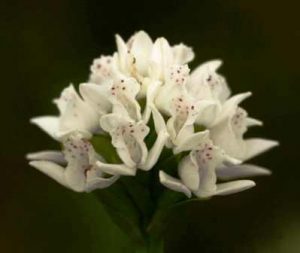
Brownleea galpinii. Photo: Bart Wursten. Source: Flora of Zimbabwe
After a storm free lunch, disturbed only by butterflies, we stopped at another large vlei, which had a very different collection of plants. Brownleea galpinii had not been seen before, but here it was common over a large area. It is a small orchid with an almost spherical head of white flowers, finely spotted with purple-brown. Brownleea is a small African genus of 7 species, three occurring in Zimbabwe. The next orchid was an even greater surprise. It clearly belonged to Disperis but no species, known from Zimbabwe, are to be found growing in a wet, grassy vlei in full sun. There was no doubt this had to be something botanically exiting. A brief survey located over 20 specimens of the plant in question, which made it easier to sacrifice a few “in the name of science”. The plants are small with leaves alternate along the stem. The cream-coloured flowers are flushed with soft pink and have a distinctly helmet-shaped hood, formed by the dorsal sepal and petals. The lateral sepals are spreading and pointed, with distinct spurs. Preliminary investigation has come up with Disperis cooperi as the most likely name for these plants. This species has only been recorded from KwaZulu-Natal and Mpumalanga in South Africa, where habitat and altitude are very similar to that of the World’s View area. If further research will confirm this, it will be a new record for Zimbabwe, and in fact for the Flora Zambesiaca region.
What a great find to finish this treeless outing with! We finally managed to arrive at World’s View just in time to see that we had to go back to Ezulwini straight away, if we still wanted to be home by dark.
If you want to see photos of the orchids mentioned in this article, then go to www.zimbabweflora.co.zw
-Bart Wursten.
KUTSAGA: 19 JUNE 2005
This was the Tree Society’s first ever visit to Kutsaga, the tobacco research station, close to Harare airport to the south of the city. I arrived quite early and was let in by the security people and parked in front of the main building with its nicely-tended gardens.
As 9.20 approached I began to wonder if I had got the right day. Or was I in the wrong place? Was I completely muddled as to the venue? Then one person arrived and then another – and that was it! Three of us! A moment’s thought convinced us that the dire fuel shortages were the obvious problem.
Despite the smallness of our group. we decided to continue with the walk and, after some discussions with the guard, we were directed to the main security office where we parked our cars and were given a friendly welcome to walk wherever we liked.
By the main road through Kutsaga, there were large quantities of an alien grass, Harpachne schimperi. This was first recorded for Zimbabwe at the airport in 1990. This area seems to be its main centre of distribution, although it has since been recorded sporadically elsewhere, for example at Mukuvisi Woodlands and Cleveland Dam, but it hasn’t become a really successful invader yet. It has attractive pink inflorescences with pendulous spikelets.
We next set off across some old lands heading in the direction of the dam. The area was at first very degraded but the number of trees and the species richness increased steadily, although it was mainly common species. Trees seen included Julbernardia globiflora, Acacia sieberiana, Parinari curatellifolia, Diospyros lycioides subsp. sericea and Senna singueana in flower. The herbaceous flora also showed evidence of degraded lands – e.g. the curry bush Helichrysum kraussianum was common.
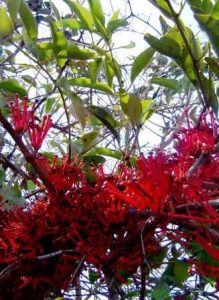
Globimetula mweroensis. Photo: Bart Wursten. Source: Flora of Zimbabwe
The soils were sandy and light and the flora was quite similar to Cleveland Dam, especially the area near the Haka game park, and Mukuvisi Woodland. Another species typical of these areas also was Protea gaguedi. This is a bit like a hairless Protea welwitschii; it is a small tree with quite attractive white flowers. This particular specimen bore a striking parasitic plant – a Loranthus – the name of which is Globimetula mweroensis. This parasite appears to be very common around Harare; it has thickly textured almost fleshy leaves and dark red flowers of the classic matchsticks type. We have seen a lot of it lately; not only does it attach itself to native trees (Ficus, Faurea and Protea are said to be its commonest hosts) but it also seems to enjoy exotics too: Salix babylonica and Populus deltoides at Greystone Park and Liquidambar styraciflua. Acacia podalyriifolia and Lagerstroemia indica at Ewanrigg.
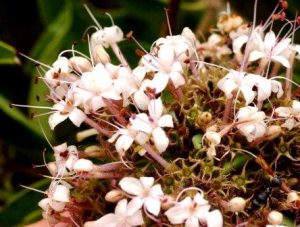
Clerodendrum eriophyllum. Photo: Bart Wursten. Source: Flora of Zimbabwe
We then crossed on the dam wall. This was also rather disturbed and apart from Clerodendrum eriophyllum (this is the new name for what we used to call Clerodendrum glabrum), there was not much to see. At the end of the wall we descended to the water’s edge, where there was an area of annual plants and plants of wet places.
Then on into Brachystegia woodland. This was the best habitat of the day, although even here there was evidence of damage in the past. Scattered through the woodland were some fine, large termite mounds, which were characteristically rich in species and of course very different species to those of the surrounding woodland.
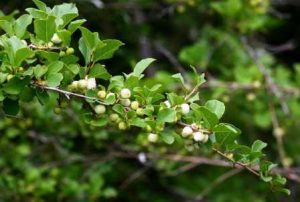
Flueggea virosa. Photo: Bart Wursten. Source: Flora of Zimbabwe
The termite mounds had Gardenia volkensii, Boscia salicifolia (often they have abundant Capparaceae), more Clerodendrum eriophyllum, Dichrostachys cinerea, Flueggea virosa, Ozoroa insignis, Euclea divinorum, Schotia brachypetala (that very characteristic species of anthills) and Ficus sur.
A slightly local species seen was Maerua triphylla. This is a shrub or small tree with 3-foliolate leaves and like the Boscia belongs to the Capparaceae.
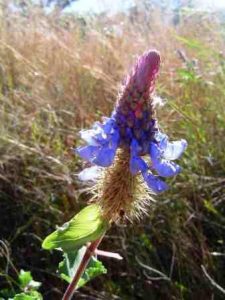
Pycnostachys urticifolia. Photo: Bart Wursten. Source: Flora of Zimbabwe
Emerging from the woodland, we walked past some grassland near the dam and were rewarded with the hedgehog flower, Pycnostachys urticifolia, with its spiny heads. Also there was Grewia monticola, easily recognised by its leaves with their white underside and markedly asymmetrical base. At about this time, we met Alistair Hull, who had arrived late and had been unable to find us – so finally we were 4.
As we walked back along the main road, we crossed the rocky stream bed above the dam and there was a specimen of Rauvolfia caffra. This is rather a local tree around Harare and this was quite an interesting record.
All in all, although nothing spectacularly exciting was seen, we felt that Kutsaga was a very welcome new place which the Society must revisit.
Finally, I would like to thank Terry Fallon and the authorities at Kutsaga for giving us permission to visit. We hope to return when conditions are a bit easier.
-Mark Hyde
ACACIA: the great name change debate continues …
In two recent articles in Tree Life, I summarized the debate which has been taking place among taxonomists about the genus Acacia and how changes may affect the current treatment of the genus.
The purpose of this third article is to report on a further recent paper on the question. I am, once again, grateful to Jonathan Timberlake for sending me a copy of the relevant paper.
The story so far
Recent research has shown that the genus Acacia must be split into 5 genera. Name changes to some of the African acacias are inevitable. The issue at stake is which of the 5 new genera retains the name Acacia.
In terms of the rule of priority, this would normally go to the new genus containing the type species of the genus Acacia. There is no ambiguity here – the type species is Acacia nilotica. Therefore the new genus containing A. nilotica would normally retain the name Acacia. This would mean that many African species would retain the name Acacia.
In 2003, some Australian taxonomists [1] put forward a proposal to re-typify the genus so that Acacia penninervis becomes the type. This species is an Australian acacia (i.e. a wattle) and this change would mean that the numerous Australian species would retain the name Acacia and furthermore that all the other species would change to new generic names.
Two major arguments were put forward in [1] to support this proposal:
- overall the number of name changes would be minimised as there are so many Australian acacias;
- the floras of Africa, Asia and the Americas will need to change the names of their acacias (to e.g. Senegalia) and leaving some of the species unchanged will lead to confusion.
The new paper
In May 2005, a further paper [2] was published. It had been written by 24 botanists from all over the world- some even from Australia. This paper argues against the proposal to move the type to Australia. The main thrust was that the original paper, [1], had not set out fully the disadvantages of the move as the International Code of Botanical Nomenclature requires.
Specific arguments against the proposal are:
- The economic impact
Acacia sensu stricto is widely distributed through Africa, Asia and America. In contrast, Racosperma, the genus to which all the Australian acacias would be transfer if the type were not conserved, is more or less confined to Australia and many species are narrow endemics.
The authors point out that Australia is one country of c.20 million people, occupying 7.6 million sq. kms. Africa, on the other hand, consists of 41 countries, 874 million people in 31 million square kms. Furthermore, many other countries in Asia and Latin America would be affected.
If the type is changed, costs would be borne by those countries least able to afford them. Australia is relatively well placed financially and logistically to make the changes required.
- Acacias vs. wattles
The Australian acacias are generally referred to as “wattles” and it is doubtful if the average person ever connects them with the name “Acacia”. On the other hand, the common name acacia is used throughout Africa and Latin America. - Expected change
Furthermore, there is some evidence that the Australian botanical community is already geared up to change to Racosperma The change was anticipated as early as 1986 and it was expected that this would happen in terms of normal botanical priority.
In summary, the new paper contends that:
(1) no detailed case against conservation was put forward in the 2003 paper;
(2) there are strong arguments against conservation, namely:
a. the large no. of countries affected;
b. the economic importance of the extra-Australian species;
c. the economic burden placed on developing countries.
(3) acceptance of the proposal would contravene the ICBN.
I understand that this proposal is to be debated very shortly and a decision made. I will post further information when it becomes available.
-Mark Hyde
[1] Orchard, A.E. & Maslin, B.R. 2003. Proposal to conserve the name Acacia with a conserved type. Taxon 52: 362-363. [2] Acacia: the case against moving the type to Australia. Luckow et al. Taxon 54(2). May 2005.
THE PETHERAM FILES Continued….. File 5 Tuli
This file was labelled Tuli, and contained a collection of notes on the Tuli Circle that Dick Petheram had gathered from various sources. Included in the notes below is an item taken out of File 1.
The Life and Death of Tuli
As the gateway to occupied Mashonaland, Tuli held sway for a brief period until the conquest of Matabeleland three years later. But its star waned as the pre-pioneer road to Bulawayo was re-opened and wagons once again lumbered through Mangwe. Then came a brief re-awakening as forces converged on Tuli to defend the country’s southern approaches during the Boer War. After the Treaty of Vereeniging Tuli slowly died, and the town that once boasted two hotels, two blacksmiths’ shops, a hairdresser’s establishment, a soda-water factory, a weekly turnover of 200 wagons, and a virile population slowly gave way to mopane bush and the depredations of elephant.
The BSAP Station at Tuli was closed down on 31 October 1941, but a new Station was established in 1952, bringing back memories of the earlier days.
The Origin of the Tuli Circle
In 1891 Khama, Paramount Chief of the Bamangwato, granted a Concession to the British South Africa Company for a tract of country south of the Shashe River, within a ten-mile (16.1 km) radius of the fort at Tuli. The idea behind the Concession was to give the Pioneers authority to keep the area free of the local indigenous cattle, which were then badly infected with lung-sickness. It was feared that they would infect the transport and other animals entering the new colony from the south.
The Concession was gazetted in Cape Town on 27 June 1891 by Sir Henry Locke, GCB, GCMG, who was then High Commissioner.
When the Boundary Commission was set up by Order in Council in 1898 it was decided that this area should be included in the then Rhodesia.
The actual survey and beaconing of the circle was not undertaken until a much later date. It was done by the Bulawayo firm of land surveyors, Maxwell Richardson and Henry, during June and July 1954. The actual work was done by Maxwell Richardson and a partner, Graham Odham (Survey Record 8029, Bulawayo).
Maxwell Richardson’s father, JP Richardson, was the District Commissioner, Gwanda, at the time of the 1896 Rebellion, and was responsible for getting the Ndebele Chiefs together to hold their first Indaba with Cecil John Rhodes in the Matopos.
Sources of information: GHT Tanser; EE Burke (Director of National Archives);
Joy Maclean (1974), The Guardians; Surveyor General’s Office, Bulawayo.
Boundaries of the Tuli District
Government Notice No 61 1897 of 5/4/97, published 28/4/987 contained the following:
It is hereby notified for public information that His Excellency the High Commissioner has been pleased to approve the subjoined regulations entitled “The Southern Rhodesia Boundary Regulations, 1897…
“The Tuli District is bounded by a line drawn from the Bubye Drift on the Tuli-Victoria Road down the Bubye River to its junction with the Limpopo River; thence westerly along the northern boundary of the South African Republic until the Shashi River is reached; thence up the Shashi River till a point ten miles from Fort Tuli is reached; thence westerly around Fort Tuli at a distance of ten miles until the Shashi is again reached; thence up the Shashi and Shashani Rivers until the range of granite hills running east and west from the Shashi River to the Umzingwani River, and passing nearly through the Purre Purre post station on the Tuli Road is reached; thence along the ridge of these granite hills until the Umzingwani River is reached; thence down the Umzingwani River to the drift on the Tuli-Victoria Road; thence easterly along that road until the Bubye Drift is again reached.
[Comment 2002: These boundaries of the Tuli District cannot be located too easily on current maps, but in HC Dann’s The Romance of the Posts of Rhodesia an 1896 map between pages 120 and 121 shows the location of the “Puri Puri” post station, which helps clarify the district’s northern boundary.]Around Fort Tuli
This section was originally part of the “address” contained in File 1, but it seemed to belong more appropriately to the subject matter of File 5.
The old hunter, missionary, and trader route through Mangwe fell into disuse for a while during the occupation of Mashonaland in 1890. Indeed, Matabeleland had to be carefully avoided, and Fort Victoria, Fort Charter, and Fort Salisbury became well-known landmarks of the route of the Pioneer Column and its accompanying police contingents from Fort Tuli. The most celebrated of the Fort Tuli trees is the baobab, Adansonia digitata, within the Tuli Circle, on which are carved the names and initials of a number of members of the Column, and the Police, and the traders of the time. Very clearly inscribed, on 10 June 1890, was the name of WE Fry, who had joined the Pioneer Corps as photographer and assistant to Selous on the survey staff. His map of the Pioneer route to Fort Salisbury, together with his very fine photographs, are among the most prized and most dependable of Rhodesiana records. The writings of AS Hickman and Robert Cary contain some interesting information on several of the men who were moved to impress their presence on this old tree.
Another baobab, this time on the left bank of the Shashe, opposite the Tuli Circle, is of note in that initials and names were outlined by cartridge cases hammered into it; but on a recent visit, Mr and Mrs Irvine and I found that a lot of these had been removed or had fallen out. Zeederberg’s old coach route is clearly discernable close by.
A third tree, further down the river, almost certainly a Ficus ingens (red-leaved rock fig) which we did not have time to see, is said to show to this day cable marks from the time when it was used as an anchor post to haul transport across the wide and difficult Shashe from the fort area.
It was at Fort Tuli that Mother Patrick and her Sisters of the Dominican Order inaugurated the country’s first nursing service on 25 March 1891. Moving on to Fort Salisbury, they opened a hospital on 1 August of that year, and on that site Mother Patrick’s two cypresses (Cupressus torulosa) were planted in 1895 or 1896, and are flourishing to this day.
[Comment 2002: Mother Patrick’s cypresses are still there, standing near the southeast corner of the redbrick Chaminuka (formerly Coghlan) Building. Access to them is denied because this is a Government precinct, and the last time they were measured was in March 1982 when they were both 31 m tall, with breast-height diameters of 97.8 and 88.9 cm respectively.]
HISTORIC TREES OF ZIMBABWE By LYN MULLIN.
Copies of this wonderful book are still available from Maureen Silva-Jones.
Telephone. Home 740479; Work 757171(Harare)
Soft Cover – $150 000.00
Hard Cover – $225 000.00
Leather Bound – $300 000.00
MARK HYDE CHAIRMAN


